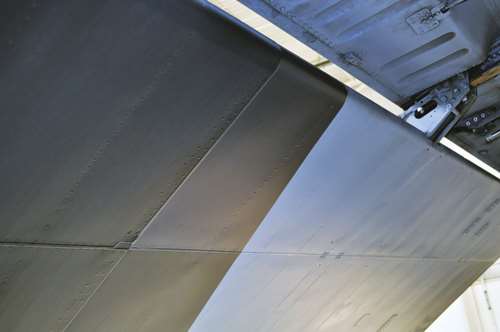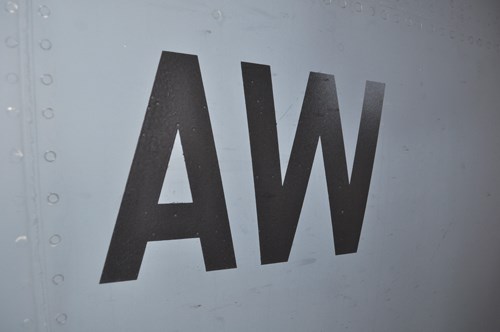Published
Accelerating Topcoats for Aerospace Specifications
Bayer’s UV-A curable coatings provide rapid cure rate, high performance
#curing #aerospace
Contributor
Mike Dvorchak and Todd Williams from Bayer MaterialScience believe the aerospace industry—tired of watching paint dry—is seeking faster-drying topcoats that deliver the high-performance properties of traditional polyurethane coatings.
“Conventional coatings based on two-component polyurethanes take as long as 72 hours to fully develop their properties, which is a considerable length of time for an aircraft to be grounded waiting for its paint to dry,” says Dvorchak, the manager of intellectual property and new media at Bayer.
Fortunately, the two men say developments in ultraviolet-A (UV-A) light sources and photoinitiators have allowed for significant progress in site-applied markets.
Williams, a senior associate scientist, says UV-A curable aerospace coatings were developed to quicken the return-to-service time while maintaining high-performance properties of established polyurethane coatings. He says these coatings use one-component formulations, which simplify the mixing and application process and can also significantly decrease return-to-service time from days to merely hours.
In addition to faster drying time, Williams says the UV-A curable coatings offer environmental advantages, such as reduced volatile organic compounds and volatile hazard air pollutants, while meeting stringent aerospace industry specifications.
Stencil Coating Development
Dvorchak points to a recent government initiative focused on developing UV-A curable aerospace coatings in an effort to decrease the return-to-service time and maintain high-performance properties for aerospace industry applications.
A UV-A curable coating formulation developed by Bayer MaterialScience underwent a battery of tests that included flexibility and corrosion analysis.
“The coating formulation displayed promising physical properties for the aerospace arena,” Dvorchak says. “Testing during a 14-month period, or about 600 flying hours, evaluated the coating’s color-change and gloss-retention properties. Initial testing showed that the stencil coatings were comparable to the conventional polyurethane fluoropolymer.”
He says the coatings even comply with the most stringent requirements for the physical properties of aerospace topcoats that are set by military specification 85285. Coatings that meet these standards are based on high-performance industrial resins that yield a good balance of physical properties, including chemical resistance, flexibility, adhesion and weathering, he adds.
“Because the cost of the coating is only a fraction of the overall painting cost, high-quality raw materials are used to formulate aerospace coatings,” he says. “These coatings are among the highest-performance systems found in the market.”
Among the challenges discovered during this round of testing was that there was room for improvement in the areas of flexibility and gloss. UV-A curable coatings based on oligomeric chemistry are typically hard and chemically resistant, which imparts deficiencies in flexibility.
Williams says gloss reduction can be challenging with this type of chemistry due to the lack of shrinkage of the polymer upon solvent evaporation. To address the color-change and gloss-retention performance issues, the stencil coating was reformulated and applied at 2 dry mils film thickness and UV cured for eight minutes at 8 inches standoff distance using an H&S Autoshot 400W light, unless otherwise specified. All coatings were evaluated on freshly primed, Alodine-treated 2024-T3 aluminum panels. Evaluations were performed immediately after curing using the guidelines provided in MIL-PRF-85285.
Chemical Resistance
Due to the high crosslink density, UV-A curable coatings tend to offer superior chemical resistance, but lack flexibility, Williams says.
“Aerospace coatings require a compromise of both chemical resistance and flexibility while maintaining hardness,” he says. “These properties are primarily dictated by the filler concentrations and the resins functionality and glass transition temperature.”
Three urethane acrylate resins and a reactive diluent were evaluated for their flexibility in the stencil formulation by preparing the formulation using only one resin. The data in Table 3 shows an inversely proportional relationship between average acrylate functionality and flexibility, as expected.
“Both the monofunctional reactive diluent and difunctional resin show improved flexibility, although at the expense of hardness,” Williams says. “This data indicates that a mixture of hard and soft resins along with reactive diluents is required to get the balance of flexibility, hardness, and chemical resistance required to meet the stringent specifications.”
Low-Gloss Requirements
Dvorchak says low gloss in UV coatings is typically accomplished by adding micron-sized silica or cross-linked polymer particles to form a rough surface that scatters light. The formulation of very-low-gloss coatings that meet MIL-PRF-85285 standards requires a large concentration of flatteners, which is detrimental to the coating’s flexibility. During the research and testing, Dvorchak and Williams say that alternative strategies were explored to maintain a balance of physical and aesthetic properties.
For example, they say Fusion UV lamps have higher intensity and are focused lights, compared with flood-style UV-A lights that emit lower intensity light. The
focused light and higher intensities enable the coatings to cure more uniformly, because oxygen inhibition is overcome at a much faster rate.
“The consumption of oxygen is faster than oxygen diffusion,” Williams says. “On the other hand, the lower-intensity UV-A light cures the coating from the bottom up, because the surface has a high oxygen concentration that inhibits the free radical reaction. Eventually the photoinitiators reduce the oxygen concentration to a level that allows polymerization to occur at the surface.”
An increased concentration of acrylate groups produces increased inhibition of polymerization at the surface, which Williams says causes the cure of the surface to occur well after the bottom layers have polymerized. Gloss reduction using full spectrum lights can be obtained by curing with a 172-nm excimer lamp followed by a mercury arc lamp.
“Reduced penetration by the 172-nm lamp limits the crosslinking to near the surface, producing wrinkled structures,” he says. “Through cure is obtained with the mercury arc lamps, yielding a matte finish. The oxygen inhibition method of reducing gloss works in a similar manner, curing the bottom layers first, then the surface, which also produces a wrinkling effect.”
Weathering Properties
Accelerated weathering has been a focus of the aerospace industry over the past decade and these properties are typically improved via the introduction of UV-A absorbers and hindered amine light stabilizers.
Unfortunately, Dvorchak and Williams say these additives can interfere with the absorbance of UV-A light by the photoinitiators resulting in partially crosslinked coatings.
“UV-A curable formulations can permit a low level of HALS additives, however they are especially sensitive to the presence of UV-A absorbers,” Dvorchak says. “Raw material selection is especially critical to obtain good weathering properties since the traditional weathering additives cannot be used at the recommended level.”
Based on the field test in real-life conditions, the Bayer scientists say the performance of UV-A curable coatings has been shown to rival that of conventional polyurethane coatings for aerospace applications. They add that using a combination of hard and soft urethane oligomers and reactive diluents formulations yielded a balance of chemical resistance, flexibility and hardness.
“These benefits demonstrate that UV-A curable coatings make it possible to complete coating applications faster, enabling grounded aircraft to return to the sky in hours instead of days,” Williams says.
For more information on Bayer MaterialScience, please visit Materialscience.Bayer.com
RELATED CONTENT
-
Andrews Powder Coating Earns Space Flight Qualification
The first-tier aerospace powder coating supplier recently had its MIL-SPEC powder coatings qualified for coating power supplies for a classified military satellite program.
-
A Protective Decorative Electrolytic Coloring Process for Aluminum
The main task of this work was to study the influence of the different parameters on the electrolytic coloring process for aluminum.
-
Overview: Aerospace Anodize Finishes
The following anodizing process overviews are provided as a means of introduction to aerospace anodizing

















